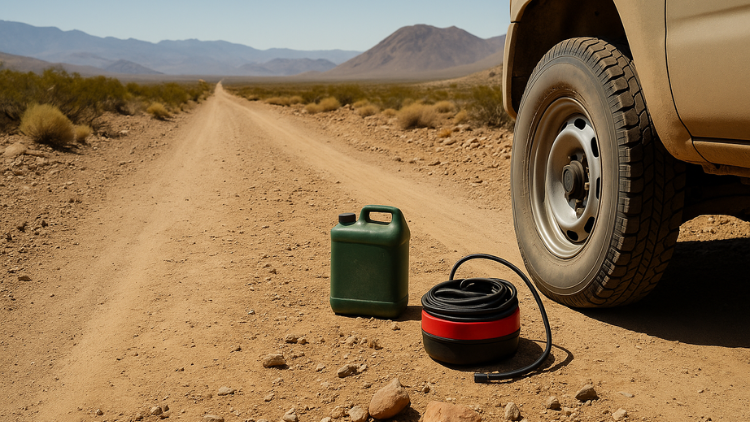You don’t need to be a hardcore overlander or van dweller to explore the wild roads that crisscross public land. But even a short day trip into BLM land or remote backcountry terrain deserves some respect—and a little preparation. Because once you leave the pavement, you also leave behind cell service, gas stations, and the kind of help that arrives quickly.
Here’s a solid guide to keeping your day trip safe, smooth, and just the right amount of rugged.
If You Have Half a Tank… You Need Gas
This is the golden rule of backcountry driving. In remote areas, gas stations can be 50 to 100 miles apart—or non-existent. Terrain, detours, and unexpected delays can burn fuel faster than expected.
Fill up anytime you dip below half a tank, especially before heading off paved roads. It’s not just about making it to your destination—it’s about having enough to get back if something changes.
Always Carry Fresh Water
You don’t need a five-gallon drum, but always bring at least one gallon per person, even for short trips. Add extra if it’s hot out or you’re traveling with dogs.
Water isn’t just for hydration. It’s also for rinsing out cuts, cleaning hands after a tire change, or soaking a rag to cool off. Keep it sealed and stored somewhere accessible, not buried under gear.
Tire Kits Save Trips
The biggest backcountry trip-killer? Tires.
Bring a plug kit and portable air compressor. If you’re venturing onto rocky, rutted, or cactus-lined paths, you’re playing roulette with your sidewalls. Even if you don’t know how to use a plug kit right now, having one gives someone else a chance to help you.
Also: check your spare. Make sure it’s full and not dry-rotted. And carry a real tire iron and jack—not the tiny emergency set that comes with most cars.
Navigation Is on You
Google Maps will fail you. Always assume no service, no signal, no blue dot.
Use offline GPS apps, printed maps, or download the BLM’s motor vehicle use maps before you go. Know the route in and out, and mark bail-out points or intersections ahead of time. A cheap handheld compass and general sense of direction can go a long way if your tech fails.
Don’t Rely on a Rescue
If you get stuck, it could be hours or even a full day before another vehicle comes by—if they come at all.
Bring the basics:
- Charged jump pack – Jumper cables are useless when no one else is around
- Tire tools and compressor
- A small shovel and/or traction boards
- Flashlight or headlamp with backup batteries
- First aid kit
- Food you can forget about until needed (granola, jerky, etc.)
- Blanket or emergency bivy, especially in cold climates
You’re not prepping for doomsday. You’re just making sure you can sit tight and ride out a problem without panic.
Tell Someone Where You’re Going
Always. Even if it’s vague, give someone a direction, timeframe, and expected return. If you don’t have cell service and something goes wrong, a friend who knows you were headed toward “that canyon north of the wash” might be your only chance at a timely rescue.
Be Road-Smart, Not Just Road-Happy
Backroads can go from “decent” to “hell no” real fast. Washouts, deep sand, mud, and jagged rock beds can stop even AWD vehicles cold.
If you’re not sure, stop and walk the section first. Trust your gut. If it doesn’t feel right, turn around. The road will still be there tomorrow.
Bonus: Know What Land You’re On
Not all land is public, even in the middle of nowhere. Make sure you’re not accidentally cutting across private ranches or tribal territory. Respect fences, signage, and gates. Just because it’s wide open doesn’t mean it’s yours to explore.
Bottom line? Day-tripping into BLM land or backcountry roads can be the highlight of your road trip—or the worst day of your year. All it takes is a little common sense and a basic kit to stay safe.
You don’t need to live out of your truck to prepare like you do. Even for a few hours in the wilderness, a little preparation goes a long damn way.



